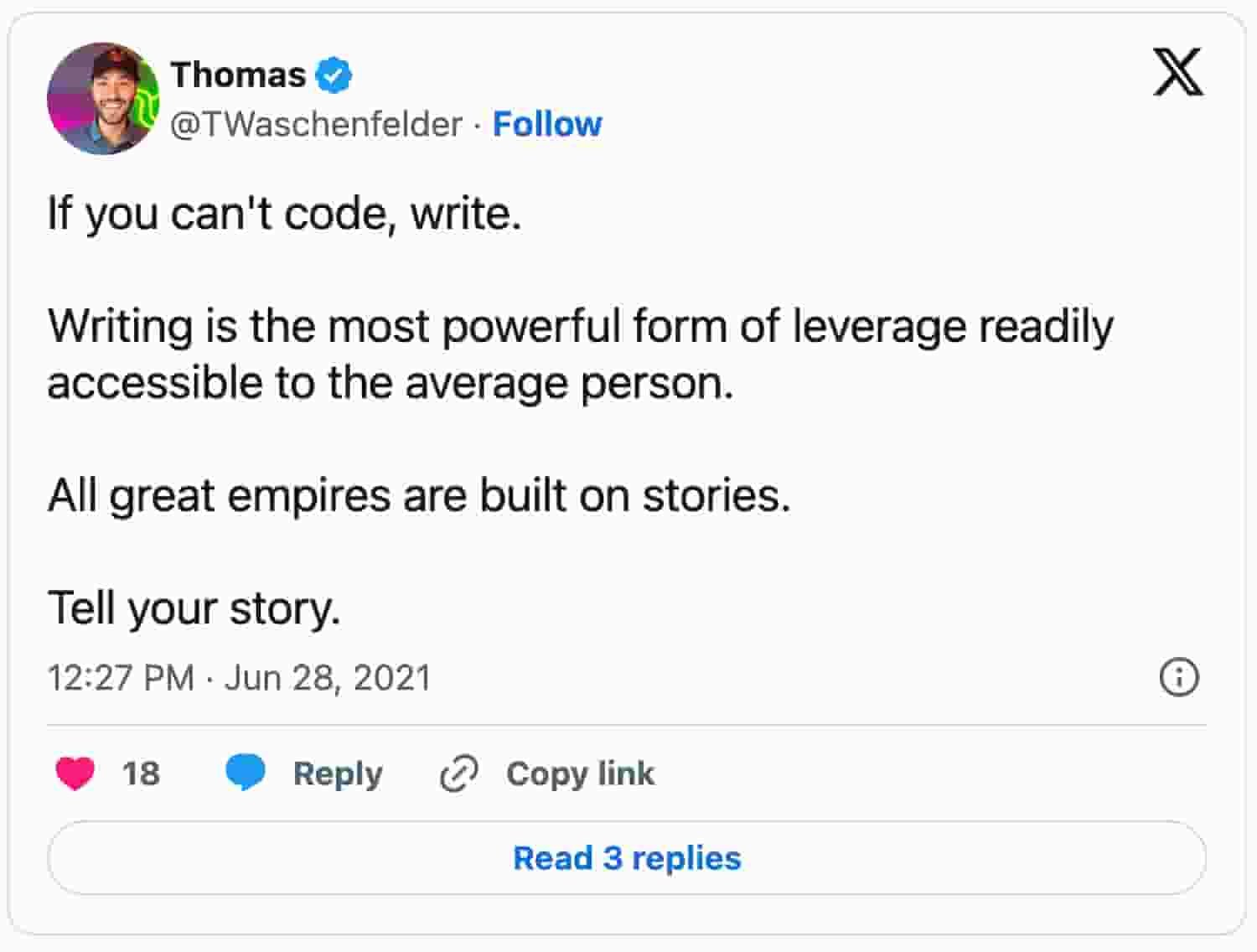To Unleash Your Potential, Take Back Your Story
“The peace that we seek is not peace of mind, it’s peace from mind.”
The only thing that’s holding you back from building the life you want is the story you tell yourself.
Most people have self-limiting stories. I can’t because… That won’t work because… I don’t know how to… Someone else has already done it… It’s a waste of time…
These are fictions we create in our minds that keep us from chasing what we really want. To unleash your potential, it’s time to take back your story.
Humans Are Natural Story Tellers.
Human beings are natural storytellers. Before the written word, oral stories were used to pass down knowledge about survival to the next generation.
Children will forget facts. But if you wrap important survival wisdom into an emotionally charged story, your children are more likely to remember it and survive. Then, they’ll pass that story down to their children and the tradition continues.
Great stories plant the listener in the shoes of the hero. There’s no difference between hearing an emotionally involving story and “experiencing it” yourself - the mind thinks it’s the same thing. That’s why stories are so powerful. To the mind, they are “real.”
Your Mind Tells Fictional Stories About The Future and The Past.
Our minds are runaway story generators. How often do you find your mind creating fictional scenarios about the future? How many of those scenarios have actually come to pass?
My mind likes to play out worse-case scenarios about events in my life - almost all of which never happen.
What about the stories you tell yourself about the past?
Our memories are mostly fiction. When we remember something, we don’t recall the event - we recall the memory that was formed during the event.
Most of our thoughts are fiction. And you don’t have to believe them.
To Unleash Your Potential, Change The Stories You Tell About Yourself.
The stories you tell yourself create your reality. If you are telling yourself a self-limiting story, you are limiting what your life can look like.
It’s possible to let go of your self-limiting thoughts and start making your mind serve you instead. Naval Ravikant writes:
“The mind should be a servant or tool, not the master… [you] want to break the habit of uncontrolled thinking.”
The first step in learning how to control the story you tell yourself is being aware of your thoughts.
Notice what they are doing. Are they running a stream of consciousness about why your work is terrible? Are they dreaming up ways your business will fail? Are they counting the defeats and ignoring the progress and successes?
Best-selling author and entrepreneur, Seth Godin, in an interview with Tim Ferriss in his book Tools of Titans, warns us that our minds often keep track of the wrong things. Godin says:
“We find ourselves caught in this cycle of keeping track of the wrong things…Keeping track of how many times it didn’t work…why? Wouldn’t it make more sense to keep track…of all the times it worked? If a narrative isn’t working, well then, really, why are you using it? The narrative isn’t done to you; the narrative is something that you choose. Once we can dig deep and find a different narrative, then we ought to be able to change the game.”
Once you become aware of your thoughts, the next step is to question them. Ask whether this stream of consciousness is true. Ask if it’s serving you. And if it’s not serving you, then stop the cycle.
As Godin says, you don’t have to use this narrative. Throw a wrench in the spokes. Hammer the breaks. Stop the train.
Use Your Breath To Break Trains Of Unproductive Thought.
I use my breath to stop the flow of an unproductive narrative.
There is power in connecting with your breathing. It instantly grounds you. It puts you back into the moment. It gives you a choice regarding what story you’re going to tell yourself next (or if you need to tell yourself any story at all).
Tony Robbins has a breathing technique he uses to prime his emotional state each morning, outlined in Ferriss’ book. It’s part of a larger state, story, strategy process to create solutions.
First, Robbins uses techniques like a cold-water plunge, breathing exercises, or walk-breathing (4 quick inhales through the nose and 4 quick exhales through the mouth) to prime his body.
Then he does a meditation-style reflection built on gratefulness, self-awareness, and visualization to prime his mind.
Finally, he builds a story of opportunity and solution-creating before forming his strategy for the day.
Once you learn to stop your unproductive stream of consciousness, you can choose what story to tell yourself. You can choose a story of hope, success, happiness, meaning, and agency.
You can choose a story where the work you do impacts the world. A story where you are creating the life you want.
Use Inversion To Ask “What If This Works?”
If you’re having trouble getting out of a self-limiting stream of consciousness, you can use Charlie Munger’s inversion model to invert your story.
Inversion is looking at the other side of the argument. Usually, it’s asking “how could my endeavor fail” in order to pinpoint the weaknesses of an idea and analyze what risks they pose.
But if you are already in a self-limiting story state, that question becomes: “what if this succeeds?” You’ve just flipped the script and opened up a whole new world of possibilities. You’ve changed your story.
Be Patient and Keep Going.
It takes time to build a habit of self-awareness. You are undoing a stream of consciousness habit that has been with you every second of the day for your entire life. Be patient with yourself. Start small and celebrate the little wins. Focus on the progress, not the lapses.
The only thing that’s holding you back from building the life you want is the story you tell yourself.
It’s time to take your story back.
If You Want More Content Like This, Follow Me On Twitter And Subscribe To My Newsletter:
—
SOURCES
Ferriss, Timothy. Tools of Titans: The Tactics, Routines, and Habits of Billionaires, Icons, and World-Class Performers. HMH Books. Kindle Edition.
Here is Tim Ferriss’ site: https://tim.blog/
Here’s Naval Ravikant’s site: https://nav.al/
Here’s Tony Robbins’ site: https://www.tonyrobbins.com/
Here’s Seth Godin’s site: https://seths.blog/
Photo by Andrew Neel on Unsplash






